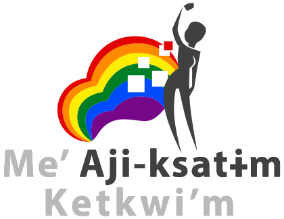In our Love Training More Equality and Inclusion Statement, we wrote about how we are all running on the unceded ancestral land of Indigenous peoples in Canada. In Nova Scotia, we run on the unceded ancestral Mi’kmaw territory known as Mi’kma’ki.
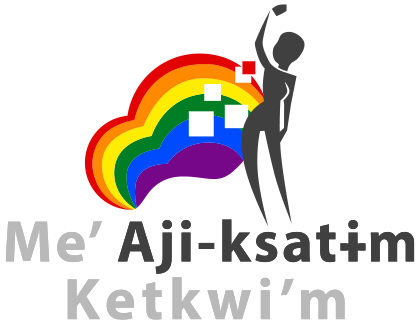
We also wrote that we offer gratitude for the beauty and strength of both the land and the Indigenous people who have occupied and used this land since time immemorial. Truth and Reconciliation must be ongoing and if we are to responsibly enjoy the land that we love to run on, we have a role to play. We should know about the history of the land where we run and the history of the Indigenous people who have lived in harmony with the land long before contact with settlers and colonizers
In order to begin to action these portions of our Inclusion and Equality Statement, the Love Training More Crew hosted an online Team Learning Session featuring Jarvis Googoo.

Jarvis was raised in We’koqma’q, Unama’ki, attended an Indian Day School, and graduated from a Mi’kmaw Kina’matnewey school. He holds degrees from Saint Mary’s University (cum laude), Dalhousie Law School, and is a non-practicing member of the Nova Scotia Barristers’ Society. He has been working in Atlantic Indigenous policy since 2013.

He has spoken and presented at many events, including Dalhousie Law School and Dalhousie Medical School, and led the development of the Donald Marshall Junior Memorial Award. He also possesses knowledge on Indigenous law, and Mi’kmaw history, culture, and language, often acting as a cultural language resource and liaison.
He has been an avid runner since 2016 and volunteers on the Run Nova Scotia Management Board. He is also an award-winning Group Fitness Instructor with GoodLife Fitness. He lives in Kjipuktuk/Dartmouth with his wife Kerrianne and their dog Looloo.
In the days leading up to our session with Jarvis, tensions on the South Shore of our Province of Nova Scotia escalated as Mi’kmaw fishers exercised their Treaty Right to engage in fishing in pursuit of a moderate livelihood. With non-Indigenous fishers threatening the safety and the rights of Mi’kmaw fishers, this conversation could not be more timely or important.
I checked in with Jarvis, a vocal advocate for First Nations people in person and on social media, prior to the session to see how he was feeling and to see if he was exhausted. Here was his response:
“While this was an exhausting weekend, I think it makes things all the more important and critical for Thursday, so I am quite looking forward to it.”
Our session with Jarvis took place on Thursday, September 24 and included a discussion of the history of the land where we run and the history of the Mi’kmaw people. We talked about how to support Indigenous runners and how to contribute to inclusive safe spaces.
Jarvis began by doing a run through of the history of Mi’kma’ki, beginning at first contact with European explorers and settlers.
A pretty comprehensive summary of history, in a compilation that included Indigenous authors can be found within HRM’s 2020 Report by the Task Force on the Commemoration of Edward Cornwallis and the Recognition and Commemoration of Indigenous History, Chapters 2 and 3.
Jarvis brought attention to the following significant historical events:
- Arrival of John Cabot in 1497;
- Contact with Samuel de Champlain in the 1600s and relationships with Grand Chief Membertou;
- Edward Cornawallis’ arrival and setting up of shop in Halifax and ensuing conflicts;
- The establishment of the Peace and Friendship Treaties in 1752;
- Presence of 13 First Nation communities in Nova Scotia;
- The passing of the Indian Act, 1867:
- Many (MANY) shocking and discriminatory measures throughout the act (see more here).
- Key point of which states that a person must give up Indian Status to become a “Canadian”
- Also under the original Indian Act, an Indigenous person can not hire lawyers until revisions in the 1950s
- Revisions to the Indian Act came about in the 1950s as the post-WWII world grappled with the systemic racism of the Nazis and a supposed wish not to emulate those racist laws in Canada
- Further amendments to the Indian Act are made in the 1980s including revisions that will no longer see Indigenous people losing their Indian Status.
- Residential Schools enacted in 1884 via Indian Act
- 1960s Scoop
- 1960: Indigenous peoples are finally allowed to vote in Canada. That is to say, Indigenous peoples had been denied the right to vote for nearly a century;
- 1969 White Paper by Trudeau’s Government, intention to abolish the Indian Act;
- 1982, The Canada Charter of Rights and Freedoms is publishing, affirming all Treaty Rights and affirming that the land was never ceded;
- Simon v The Queen case in 1985 is the first case that legally upholds Treaty Rights (the right to hunt). See more here
- Class Action Lawsuits for Survivors of Residential and Indian Day Schools;
- 2008 Apology by PM Stephen Harper for Residential Schools. This apology does not include Indian Day Schools; and
- Traditional Mi’kmaw governance, and the Assembly of First Nations and their role.
The Running Community

Jarvis then led a conversation on the running community today.
Jarvis shares that he has both a passion and a felt responsibility to promote physical activity and running within his community because of its physical and mental health benefits. He highlights that the Nova Scotia Mi’kmaw Summer Games have been instrumental in bringing community members into sport. These began in the 1970s. The games were a massive undertaking for communities. A brief hiatus occurred and the Mi’kmaw Summer Games have now taken place annually since 2010. You can read more about the history of the Mi’kmaw Summer Games here.
Jarvis notes that he continues to see colonial impact on the health of Indigenous communities today. This impact can extend to participation in sports like running.
Jarvis notes that the start lines featured in the Mi’kmaw Summer Games are robust. He rarely sees more than one or two of these runners at road races across the province and there are many times when he is the only runner from the Mi’kmaw Summer Games toeing the line at local road races.
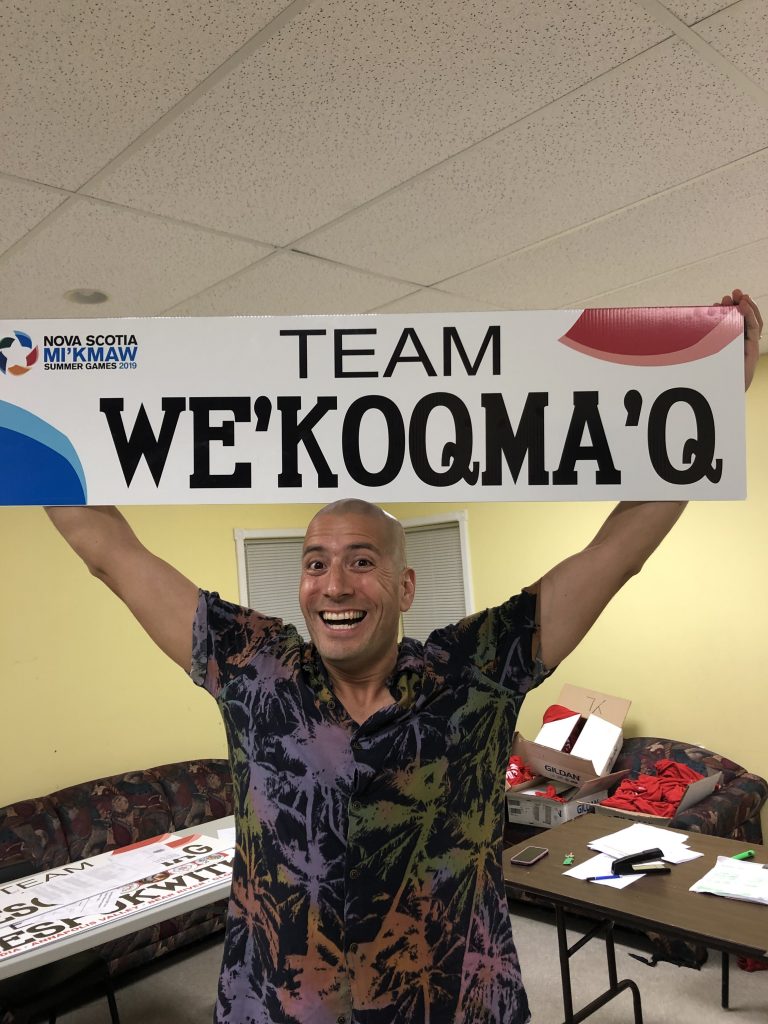
Many factors were discussed as contributors to the absence of Mi’kmaw runners at road races.
We discussed feeling welcoming and seeing yourself represented at the races; similar themes to our discussing with Black runner Gerald Parris. We talked about there’s more to “welcoming” than just stating: “this is an event where all people are welcome.” Reaching out specifically to communities would matter more than a broad statement. Broad statements may not be felt to be genuine. Barriers to participation were discussion with financial barriers being one key barrier. This led us into conversation about what Jarvis would like to see at road races.
What would you like to see at races?
The implementation of some of the factors about to be listed at local road races may lead to the presence of more Indigenous runners and ultimately, a more diverse and inclusive running community.
Representation via Nation Flags
Jarvis shares that he would love to see the flags of the First Nations of the land where the road race is being held. In Mi’kma’ki, Jarvis would love to see a Mi’kmaw flag flying anywhere a Canada flag is flying. Jarvis has participated in the Epic Canadian Road Race Events on July 1 weekend and after racing in a finishing chute of Canadian flags, Jarvis asked race director Tim Chesnutt to include a Mi’kmaw flag and he did.

Jarvis presents Tim with Mi’kmaw Flag 
Epic Race Event
Jarvis would also love to see race directors place a flag of the First Nations of that territory’s flag on the race website. Jarvis would also like to see the race directors include an accompanying statement reading that we are all Treaty People and that the race takes place on the ancestral, unceded territory of the applicable First Nations. For example, a road race in Nova Scotia would acknowledge that the race takes place in Mi’kma’ki, the ancestral and unceded territory of the Mi’kmaw. This would encourage Indigenous runners to feel acknowledged, recognized and welcomed on their own homeland and traditional territory.
Land Acknowledgement
Further, Jarvis shared that he would love to hear a Land Acknowledgement read at the beginning of each road race, prior to the race emcee dishing our safety instructions, last course specifics, etc… This would contribute to Indigenous runners feeling valued and welcomed and represent that the race is knowledgeable of and engaged in Truth and Reconciliation and Peace and Friendship. Jarvis shares that he believes that Land Acknowledgements package a lot of positive meanings, including the aforementioned.
Diversity at Race Cheer Stations and Expos
Jarvis shares that he loves the energy at cheer station in big city races. He would love to see races actively seek out Indigneous musicians or artists for cheer stations so that Indigneous talent is represented and showcased and Indigenous participants feel valued and seen. Cheer stations include musical ensembles and, for example, they could hire Mi’kmaw drummers.
Similarly, if there is entertainment associated with race expos or celebrations, efforts could be made to include Indigenous artists.
Race Representation in promotional materials and social media
It was discussed that a significant portion of local race promotional material and social media includes White bodies and in many cases, it includes the same White bodies. The crew acknowledges that the runners who are often featured are fine people but they have received ample attention and we would love to see more efforts by race directors to present a diverse racial representation in their media. This would include social media posts, promotional materials such as newspapers and traditional print advertising.
As we’ve covered in our session with Gerald Parris (see here) and Love Training More advocacy with Canadian Running Magazine (see here), the representation of runners in media is a critical component of disseminating and affirming the message that running is for everyone. If care is not taken and efforts are not made to ensure diverse representation in media, it will (continue) to appear that running is for White people and this is simply neither just nor true.
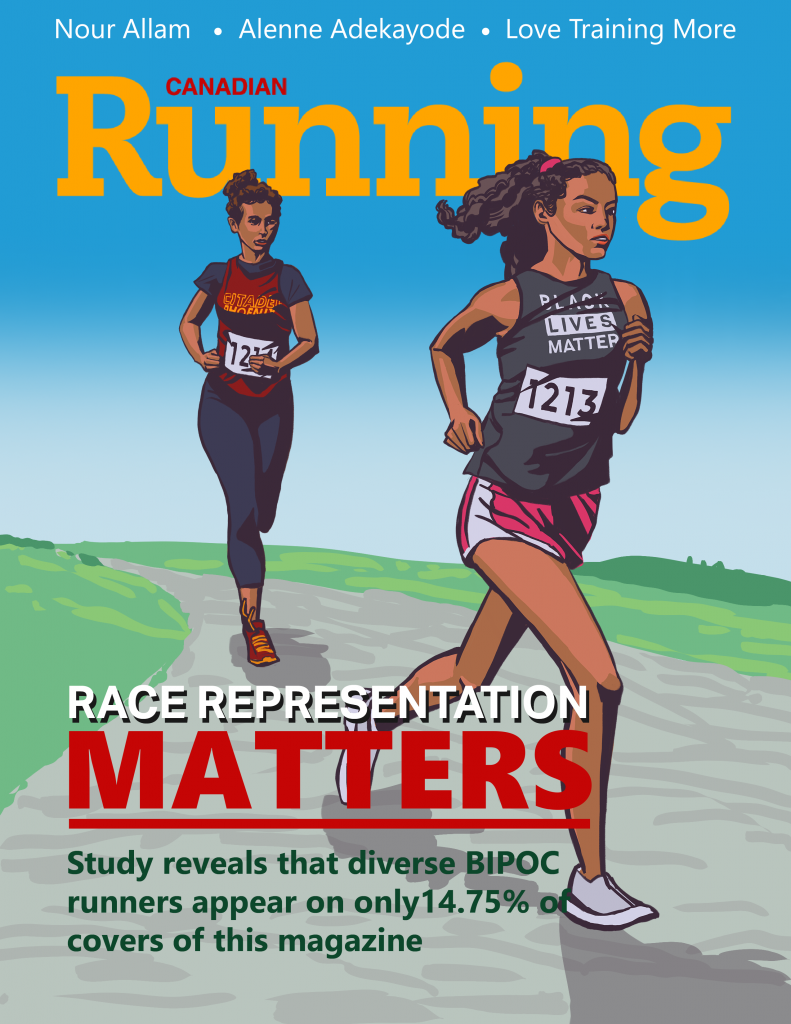
More of This. 
Less of This
Reducing Financial Barriers
Financial barriers that many communities face in participating in road races were briefly discussed. Jarvis was an active participant in a similar discussion with our session with Gerald Parris. Here we confirmed previous dialogue that the measures enacted to address financial barriers should not include many hoops to jump through or numerous onerous steps to follow. If there are hoops and many time-intensive steps, this will continue to be a barrier to participate.
Allyship and Amplification
Love Training More is committed to supporting Jarvis’ recommendations for races and will endeavor to amplify the voice of Mi’kmaw and Indigenous runners in as many avenues as possible.
Questions from Love Training More Crew
Question by Doreen:
“I have learned about Two-Eyed Seeing (Etuaptmumk). I’m wondering what we could learn from this Mi’kmaq perspective when it comes to our running training and also when it comes to being inclusive to runners from diverse perspectives.
Jarvis responded explaining that the answer to this question is challenging because the Mi’kmaq ARE inclusive by nature. He talked about more about Two-Eyed Seeing balancing out western and Mi’kmaq perspectives.
Question by Erin:
“You are a survivor of an Indian Day School. Your people have been through so much and have been effectively oppressed for centuries by the colonial settlers of this land and that continues to today, generations later, by the same people. Yet I see you consistently writing that you believe in Peace and Friendship. You are so open and authentic and generous with the future generations of your oppressors. In your bio, you write that you often act as a cultural liaison. How do you this? How have you remained so resilient and so generous and such a believer in Peace and Friendship?”
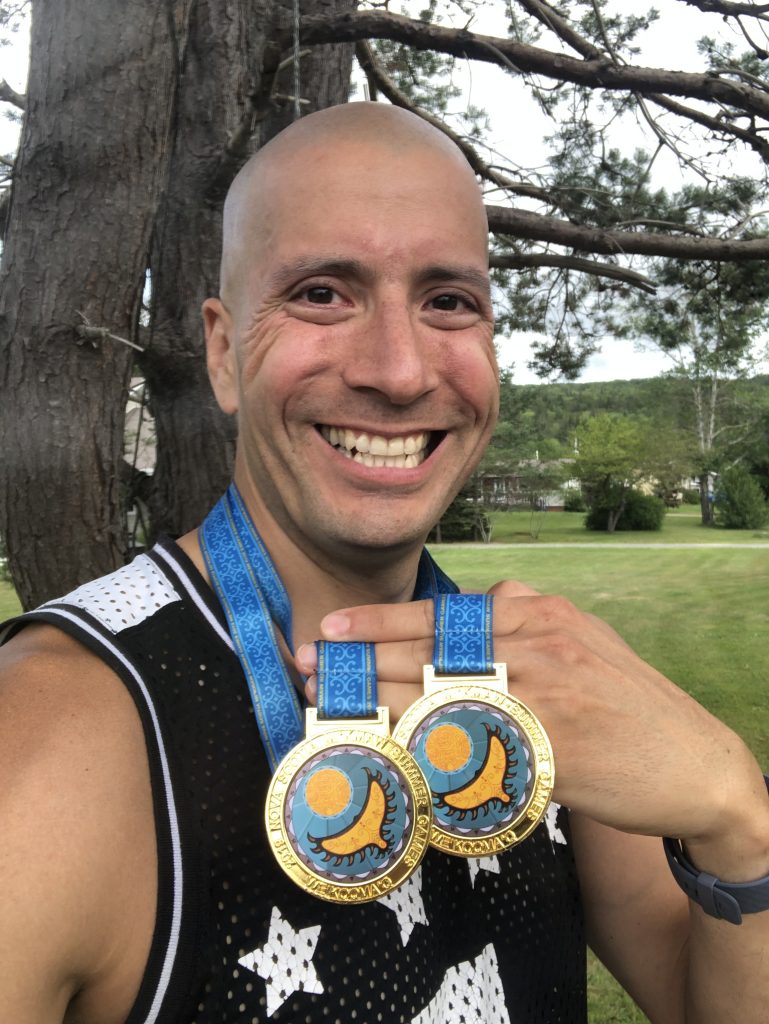
Jarvis responded with an anecdote from his SMU days:
“At Saint Mary’s University, I took an incredible course with Dr. Val Marie Johnson called Law and Society. It examined the history of how law affected people re race and gender. We learned a lot about racism, sexism, homophobia, colonialism, etc.. One student asked the professor, “How does learning all of this not depress you? This is all so sad.” She responded by saying that, while history has been oppressive, there is always hope in working towards making this better. Some things have improved thanks to the work and efforts of those who advocated and spoke out. For me, I know the issues and challenges that the Mi’kmaq have faced, and continue to face, have been awful. But I know we have made progress. Some racist laws have been overturned, and some of our rights have been upheld by the courts.
I also think about my cousin Donald Marshall Junior. Despite what he went through with his wrongful conviction and imprisonment, and having to take his fishing rights case to the Supreme Court of Canada (and won), he was a human being that had so much taken from him, and yet, was always willing to help others when he could. After spending 11 years in prison for a crime he never committed, he had all the right in the world to be hateful, and he never was. I think about how he would always try to help out others when he could, to give back when he could even though so much was taken away from him. His story and his life is a part of what inspires me today to help others. I firmly believe in making things better, and I love sharing Mi’kmaw history to help others learn about us.”
Post-Script:
Jarvis met with Atlantic Chip Owner and Race Director Troy Musseau following our session in advance of the September 27 in-person Atlantic Chip Industrial 5km regarding the inclusion of a Land Acknowledgement before the race begins. Troy wanted to include a Land Acknowledgement and Jarvis worked with him to develop his script.
A Land Acknowledgment was read at the September 27 Industrial 5km. Jarvis was on the start line.
Race Director Sherri Robbins of the Valley Harvest Marathon and the Blue Nose Marathon agreed to meet with Coach Erin to learn more about the recommendations that came up during both Gerald and Jarvis’ sessions. Sherri has already been working with NAIG (North American Indigenous Games).
In a final conversation between Coach Erin and Jarvis, this is what Jarvis had to say, his final thoughts:
Once again, I truly appreciate the invitation and opportunity for tonight. I left feeling very uplifted and inspired about what can be done in Nova Scotia and Mi’kma’ki and ensuring running is for everyone, including/especially our BIPOC communities.
Wela’lin.

